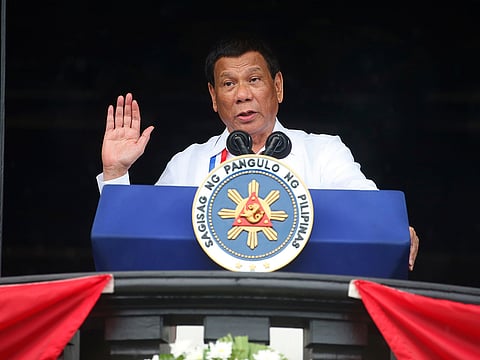Duterte vows to step down once federation is in place
Philippine president calls for combination of self-rule and shared rule under federal set-up; 18 states under one president envisioned

Manila: Philippine President Rodrigo Duterte has reiterated his plan to step down from the presidency once his term ends and a federal form of administration is in place.
“The time for federalism has come to our country. We have to move away from the style of unitary government,” Duterte said on Saturday evening in Davao City before Muslim leaders.
“We’re just trying to perfect everything and if you want a new leader during the transition you can provide for that in the law itself … and I would be happy to step down,” the president said.
Prebiscite
Duterte’s six-year term in office ends in 2022 and it is projected that, by that time, all the requisites needed for the smooth transition towards a federal form of administration, including holding a plebiscite, will be in place.
The proposed shift to a federal form of government — which would come in the form of a Charter change or Constitutional amendment — would mean devolving (or sharing) power monopolised by the national/central government to federal states (or regions).
Some lawmakers also want an extra measure to curb the age-old proliferation of political dynasties in provinces and regions.
Transition
The president had said he wants to leave a legacy and be remembered as the leader who led the transition of the country from the present presidential-unicameral to a parliamentary-federal form of governance.
Duterte likewise dismissed speculation that the reason he was favouring federalism and the transition towards that form of administration was so he could prolong his hold on power.
“Accusations that I want to extend my hold on power are garbage,” he said.
“The sole reason why I am holding out is because I do not want trouble,” he added, while pointing out that he was elected in May 2016 to serve for six years as president.
Duterte had earlier formed a panel of experts, the Consultative Committee (Concom) to review the 1987 Constitution.
The president said he wants the form of administration in the country changed to federalism to better spread out development which he said had been largely concentrated in Metro Manila and other urbanised areas such as Metro Cebu and Davao City.
Federalism Roadshow
Meanwhile, Interior Assistant Secretary and Spokesman Jonathan Malaya said the “Federalism Roadshow” is slated to kick off and tour the country starting June 17 in Dumaguete City in Central Philippines.
“We want to ensure that the message we want to convey concerning federalism is clear to Filipinos,” he said.
Senator Koko Pimentel, a chief advocate of federalism along with his father, former Senator Aquilino Pimentel, said the Concom framers envision to divide the three main islands of the country — Luzon, Visayas and Mindanao — into 18 federal regions with a nationally-elected President and Vice President.
EXPLAINER:
Can a federal form of government help solve the country's woes?
Numerous tribal groups had existed in the Philippines for millennia, with their own colourful and distinct cultures. Some are sea-based, others are highland dwellers. These include the people of the Cordilleras (Igorot, shown here), who live in the Luzon highlands; the Mangyan of Mindoro; the Negritos including the Aeta in Luzon and the Ati of Panay; the tribes of Palawan; the Lumad of Mindanao (including the Manobo, Tasaday, Mamanwa, Mandaya, and Kalagan); The Moros of Mindanao, including the Bajau of the Sulu Archipelago. Among the low-landers, there are various linguistic groups. Courtesy: Edgar Alan Zeta-Yap
Sign up for the Daily Briefing
Get the latest news and updates straight to your inbox



